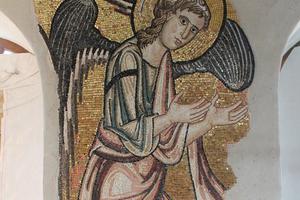Preserving Christ’s Birthplace: Restoration of Church of the Nativity Nears Completion
In the restoration of the ancient stone church there is still important work to be done.

BETHLEHEM, West Bank — In 2013, parts of the Church of the Nativity, built atop the site where Jesus was born, were in danger of collapse.
Today, the restoration of the ancient stone church is nearing completion, although there is still important work to be done.
During a recent tour of the church before Christmas, Mazen Karam, CEO of the Bethlehem Development Foundation (BDF), said the restoration has been a holy mission.
“This restoration wasn’t a choice. It was a duty. We could not allow the church to deteriorate, so it is here for the next generations,” Karam said as he entered the church, whose gold-tinted wall mosaics have been renewed to their former splendor.
The restoration “will ensure that the church will survive for at least 500 more years without major interventions, and hopefully survive another 2,000 years,” Karam said.
Due to delays caused by the COVID-19 pandemic, the restoration will take another year to complete. Bethlehem Development Foundation was responsible for raising $2.65 million of the restoration’s $18-million price tag.
Although the church had been showing its age for decades, it wasn’t until 2009, when the Palestinian Authority established the Presidential Committee for the Restoration of the Nativity Church, that momentum began to build.
The authority hired experts to examine the church’s structure and prepare a course of action.
Built in 339, the church was destroyed in the sixth century by the Samaritans. Rebuilt the same century, it was greatly expanded over the years.
While it was repaired at various times over the past 1,700 years (the last major repair was in 1480), time and tens of millions of pilgrims had taken their toll.
The unstable roof, windows and walls leaked to such an extent that murals, mosaics and internal wooden beams were badly damaged. Candle soot coated the walls, obscuring the priceless mosaics, and left the church dark and gloomy.
However, before the restoration could begin, millions of dollars needed to be raised, and the three religious custodians that maintain it — the (Catholic) Custody of the Holy Land, the Greek Orthodox Patriarchate and the Armenian Orthodox Patriarchate — needed to put aside their centuries-old differences and agree to the project.
The monumental restoration of the venerable church, which was designated a World Heritage Site in 2012 and immediately placed on the “structures in immediate need of repair” list, involved an international team of nearly 200 architects, engineers, restorers, chemists, biologists, geologists and archeologists.
Piacenti, a 150-year-old Italian restoration company that has also restored the Uffizi Gallery in Florence and many other famous buildings, spearheaded the project, along with the Bethlelem-based Community Development Group, a local architectural, engineering and project management consulting firm.
The restorers worked from top to bottom, standing on layers of scaffolding.
The first thing they did was repair and conserve the rotting roof using materials from 300- to 400-year-old Italian churches. Then came the windows and work on the main entrance and eastern door of the narthex, the basilica’s main entrance.
The restoration of the basilica “was a priority” to protect the church’s main entrance, according to the Palestinian Presidential Committee.
During the work, restoration specialists were able to uncover a hidden upper section of the enormous wooden eastern door.
While repairing the baptismal font, the restorers were delighted to discover an original font, carved out of stone and shaped like an Orthodox cross.
“In the days of early Christianity, you could walk into the font,” Karam said.
“We didn’t know it had been made smaller” at some point in history. From both a structural and aesthetic point of view, restoring the wooden architraves, the wooden beams located above the capitals, was a priority. Analysis found that they dated back to the sixth century.
Mosaic restoration specialists surveyed all 125 square meters (1,345 square feet) of wall mosaics, which were covered with rainwater debris, and discovered a new fragment of an angel on the north wall.
In addition to mending the marble floors, the restorers painstakingly repaired the church’s beautiful mosaic “carpets,” which are located in the nave and transept north.
Archaeologists also excavated the site, which is located roughly 31 inches below the floor visitors walk on and protected by removable wooden beams, and discovered extensions of the existing geometric carpets.
Finally, Bethlehem Development Foundation has been able to restore the church’s 50 columns, 32 of them featuring paintings, by organizing an “Adopt a Column” campaign. BDF is still seeking $2 million in donations to repair the external and internal stone floor tiles and to install a climate-control system.
“Humidity attacks the roof and wood,” Karam noted.
Karam said the yearslong restoration project has already brought joy to local Christians and visitors alike. “This is the birthplace of Jesus — here, it all happened. For Christians, being in Bethlehem, where Mary and Joseph stayed, reinforces our Christian faith.”
Ancient though it is, he added, “this is a living church.”
HOW YOU CAN HELP The Bethlehem Development Foundation works with its sister organization, The American Friends of Bethlehem Development Foundation, to restore the Church of the Nativity, https://afbdf.org/.

















